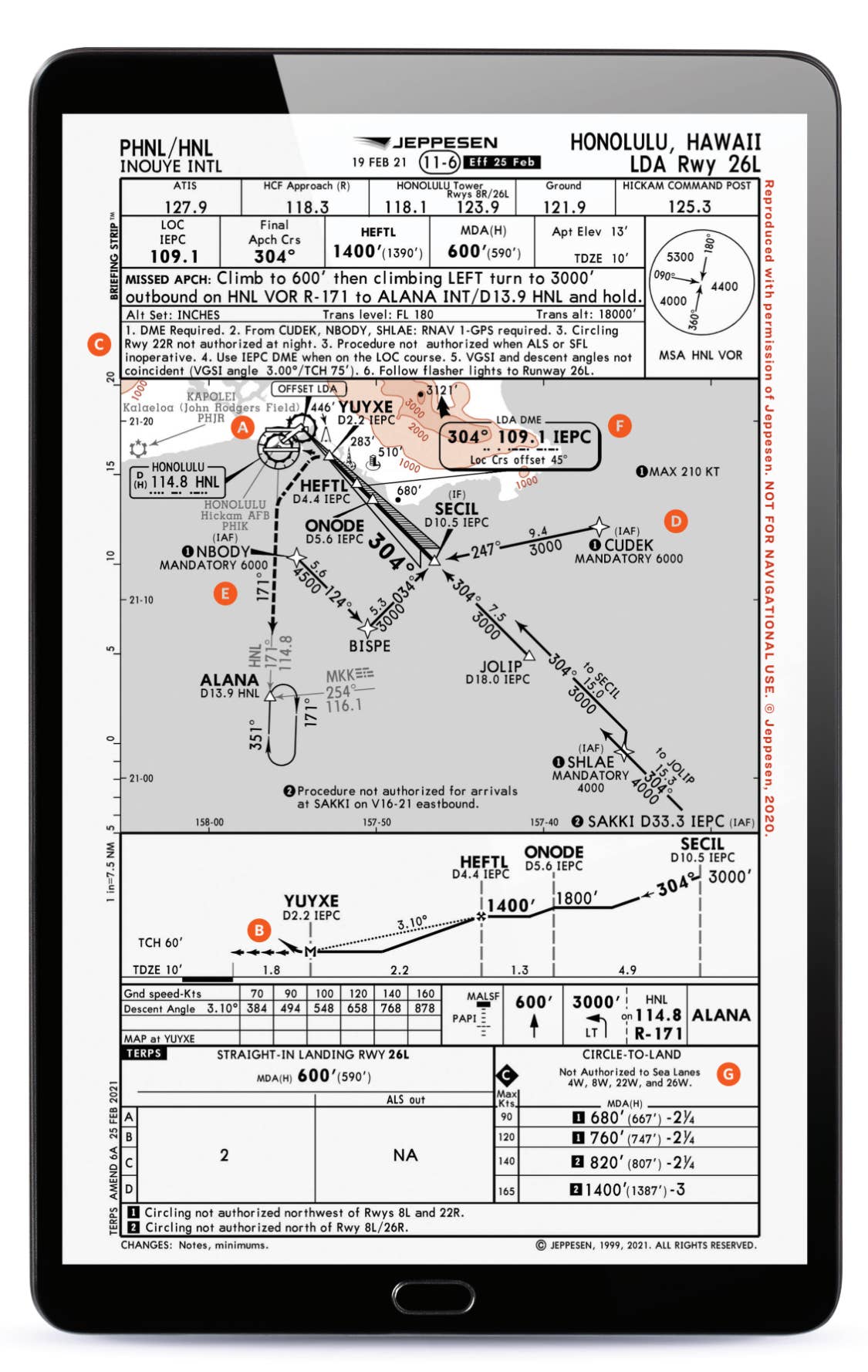The Unique Approach to Honolulu’s LDA RWY 26L (PHNL)
Here’s a breakdown of the LDA approach into Runway 26L at the O’ahu gateway airport.

PHNL LDA Runway 26L [Reproduced with permission of Jeppesen]
Planning a little flying around Honolulu, Hawai‘i? Following along like the aviation dork I am on an airline flight, as you check out the approach plates the crew might be using; or just looking for a busy approach to test your knowledge? You might run across the LDA approach to Runway 26L at Daniel K. Inouye International Airport (PHNL). It’s an approach plate with lots going on—but don’t forget to look ahead if you break out high enough, as you’ll be aimed at the historic grounds of Pearl Harbor, before you follow the flashing lights on in to Runway 26L.
A. LDA: At an Angle
An LDA approach is a localizer-type directional aid that isn’t necessarily aligned with a specific runway. In this case, it’s designed to approach Runway 26L even though the final approach course is 304 degrees—a change of roughly 40 degrees to the final direction of landing. Why would they do this? From the plan view, you can see terrain features topping out at 3,121 feet msl to the east of the airport, so a straight-in approach isn’t going to work.
B. Flashing Lights?
Note 6 indicates that a pilot may “follow the flashing lights to Runway 26L.” Using this approach, as a pilot transitions to the minimum altitude and breaks out of the clouds there will be a sequence of flashing lights that will lead them to the intended landing runway, 26L. This is presumably to help reduce confusion on which runway you will be landing as the localizer course is based at the end of 26R and a landing is intended to be on 26L. Make sure you line up with the correct runway if flying this approach.
C. GPS Required?
You can establish onto this approach using one of several initial approach fixes (IAFs). A pilot might choose to use NBODY, CUDEK, SHLAE, or even the SAKKI intersections to feed their aircraft onto the approach. Most of these will require the pilot to use the GPS even though the primary inbound navigation source for this approach will be a localizer frequency. While it is possible to use vectors—and VHF navigation sources for the missed approach—GPS sure makes this one easier to manage.
D. Mandatory Crossing Altitudes
Many fixes on approaches have “minimum” crossing altitudes. On this approach, many of the crossing altitudes are “mandatory.” We can see that at NBODY and CUDEK there are mandatory crossing altitudes of 6,000 feet, and at SHLAE it’s 4,000 feet. This is typically done on approaches where overlying airspace traffic would not allow a pilot to transition over these fixes at higher altitudes.
E. Confusing Missed Approach
The missed approach asks a pilot to climb, then turn and follow the Honolulu VOR (HNL) 171-degree radial to intersection ALANA using HNL and Molokai VORTAC (MKK). Initially, a pilot might think this means to fly over the HNL VOR, but with the missed approach point being 1.8 miles from the runway—a DME point of 2.2 from IEPC—the turn will actually take the pilot left and south of the HNL VOR to intercept this radial.
F. Pick the Correct DME
While most pilots will fly this with the approach loaded in the GPS system and get their DME from there, there is a note to use DME from IEPC when on the localizer course. When flying this approach with a more traditional instrument package, a pilot might accidentally use the HNL VOR DME, which is not located at the same position.
G. Unique Circling 'Limitations'
There’s a note that this approach cannot be used to circle to Runway 22R. But this isn’t the only note. In the bottom right corner of the plate where circling minimums are listed for different aircraft speed categories, another note indicates that circling is not authorized to “Sea Lanes 4W, 8W, 22W, and 26W.” The “W” in each of these is an indicator that there are “runways” of water designated for seaplane operations at this airport. The upshot? You can’t use this approach to land on the designated water runways.

Subscribe to Our Newsletter
Get the latest FLYING stories delivered directly to your inbox






